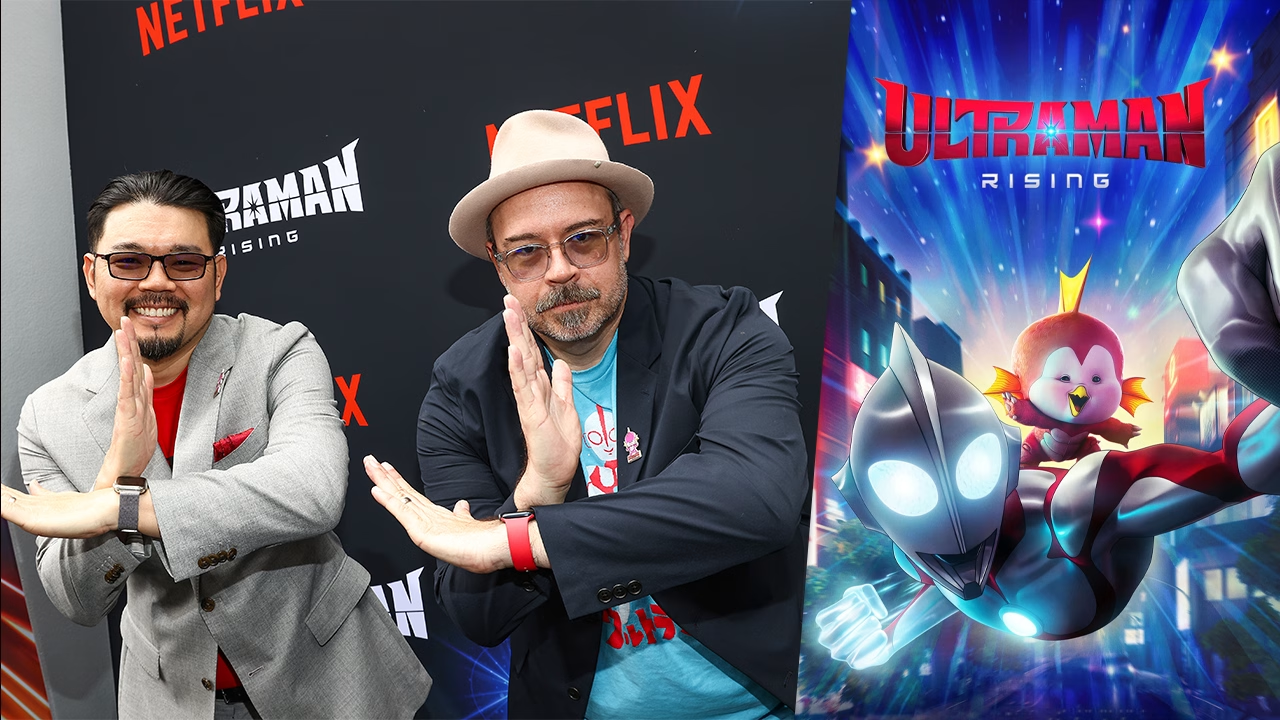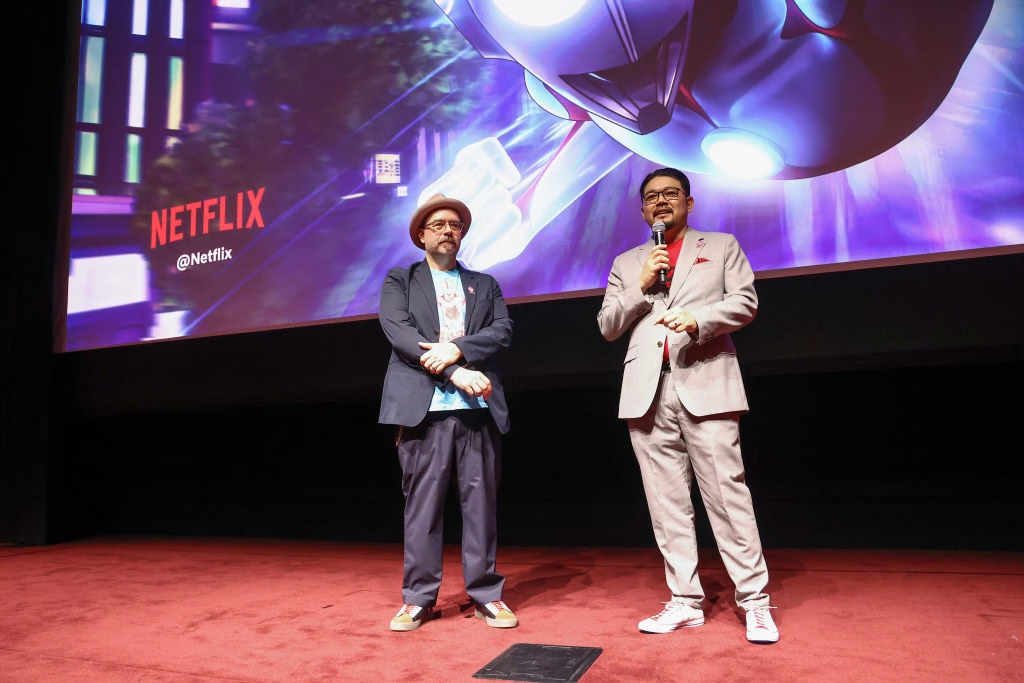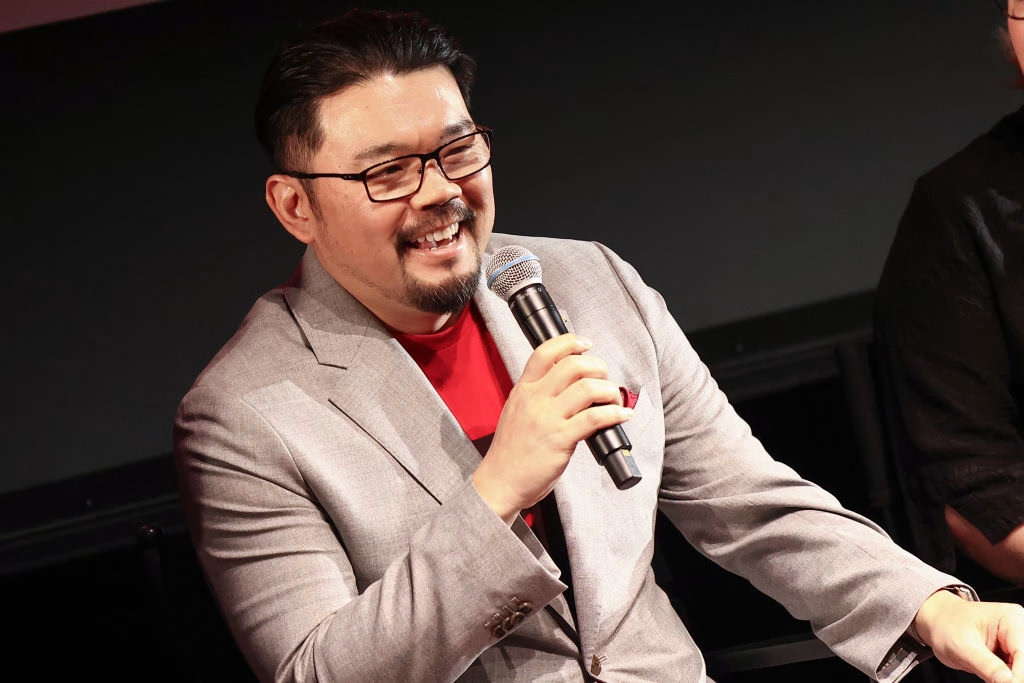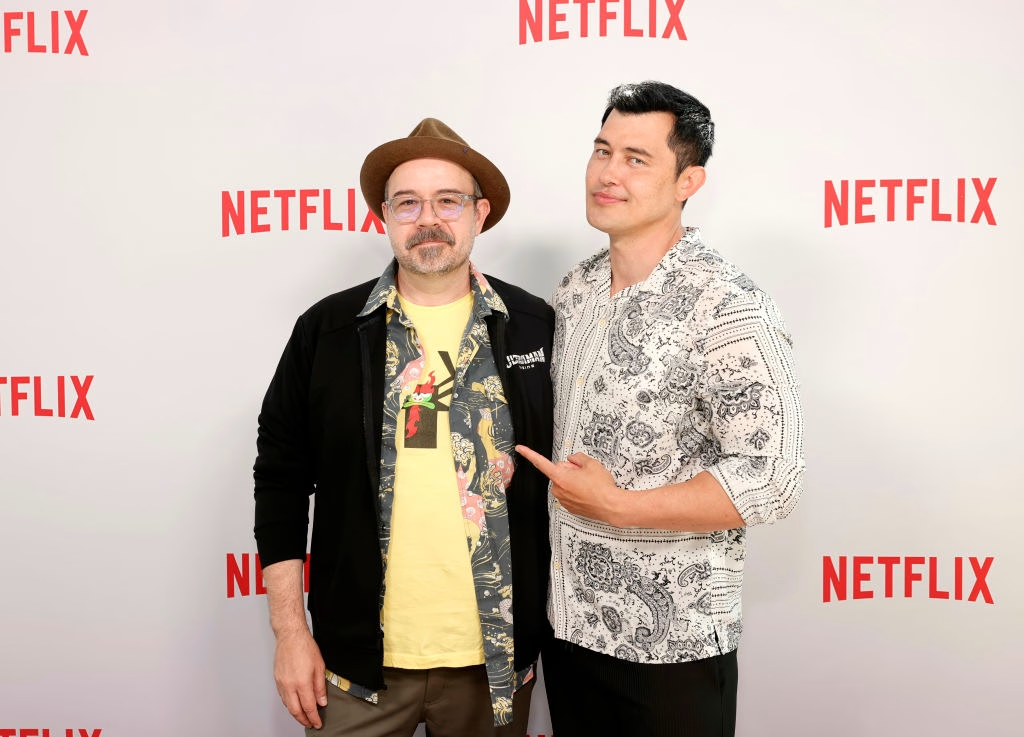
LOS ANGELES, CALIFORNIA – JUNE 01: (L-R) John Aoshima and Shannon Tindle attend a special screening of Ultraman: Rising at Netflix Tudum Theater on June 01, 2024 in Los Angeles, California. (Photo by Tommaso Boddi/Getty Images for Netflix)
Ultraman: Rising is now on Netflix, and we recently had the pleasure of sitting down with directors Shannon Tindle and John Aoshima to discuss the latest iteration of Japan’s beloved superhero.
Ultraman: Rising is an animated Netflix Original film directed by Shannon Tindle and co-directed by John Aoshima.
Netflix subscribers will be familiar with Shannon Tindle’s work, the creator of Lost Ollie. Outside of Netflix, he has worked on many beloved animated titles, such as Kubo and the Two Strings, Curious George, Coraline, Spongebob Squarepants, Foster’s Home for Imaginary Friends, Samurai Jack, and The Fairly OddParents.
John Aoshima worked with Shannon Tindle on Kubo and the Two Strings, and Netflix subscribers will have seen his work in the fantastic animated series Maya and the Three. He has also worked on many other animated titles, such as American Dad, Ducktales, Gravity Falls, Family Guy, Avatar: The Last Airbender, The Simpsons, and Futurama.
Ken Sato, a world-class baseball player, returns to Japan from America to join the Giants’ baseball team, but in secret, he returns to take on the mantle of Ultraman from his father. As Sato struggles to adjust to his new life as Ultraman, his duties as Japan’s protector become even more complicated when he becomes responsible for a baby kaiju.
How did you first become involved with Ultraman: Rising?
Shannon: In 2001, I conceived an idea inspired by Ultraman. I had watched Ultraman as a kid, loved it, and then reconnected with it when I moved to Los Angeles and learned of the character’s large global footprint. At that time, Ultraman Tiga was the big show, and now, living in LA, I didn’t have access to anything because I grew up in rural Kentucky. So then I started to think, what if I told a story with a character like Ultraman but threw him a real-world problem that a large audience could relate to that might not know anything about characters like Tokusatsu?
That manifested as this guy who’s got a huge ego, and we find out that his big issue is that his father was the original Tokusatsu hero. He’s forced to take on the mantle of this thing that he resents, and then when he does it, he has to raise this giant baby kaiju now, this thing that’s supposed to be their enemy. So that felt like, in terms of conflict, I’m always looking for conflict in stories because it’s what interests me in storytelling and an individual struggle.
Then, as I carried it on, I had a daughter about ten years into thinking about it, so then it became a lot more real to me because I wasn’t telling a story from the perspective of a child to a father; it was from a father to a child. And I was developing it that way, so it wasn’t an Ultraman film, it wasn’t until the project went into turnaround at another studio, and I went to pitch it at Netflix, and they said, what would you think about making this an Ultraman film? We know it’s inspired by it, and Tsuburaya has freed up the rights because there have been all these rights issues for years.
They asked if I would consider that, and I said only if I could tell this story. I want to tell this story about a struggling character. I don’t want to make an Ultraman movie for the sake of making an Ultraman movie. Fortunately, Tsuburaya loved the idea, and fully supported it, and then we started to work to incorporate the specific Ultraman movie into the film.
John: I’ve known Shannon since college at CalArts. He loves Japanese pop culture and everything about animation. We became fast friends and then roommates. He showed me a sketch of this idea with Ultraman in it, and I was like, holy cow, you know Ultraman? That was my first interaction with Ultraman and Shannon. But later, we got to work together on Kubo and the Two Strings, and later, he said, I have a project that I’ve been pitching around that’s inspired by Ultraman. So, I joined him on that Sony project. When it happened there and came to Netflix, I joined him again. I was like, I’m not going to miss an opportunity. But at that point, it became a real Ultraman project, so I was super excited.

LOS ANGELES, CALIFORNIA – JUNE 01: (L-R) Shannon Tindle and John Aoshima speak onstage during a special screening of Ultraman: Rising at Netflix Tudum Theater on June 01, 2024 in Los Angeles, California. (Photo by Tommaso Boddi/Getty Images for Netflix)
Jacob: What does Ultraman mean to both of you? For someone like me who didn’t grow up with Ultraman but certainly felt the franchise’s influence thanks to growing up with Power Rangers, and without Ultraman, you don’t get Kamen Rider or Power Rangers.
Shannon: I associate it with sitting with my dad and watching on Saturday afternoons. So there’s that connection. And then, when you get deeper into the lore, you understand that there are huge family elements, not just on the science teams, like the triple SP in the original series or the Ultra Garrison in Ultra 7. There are those things that carry through it. But also, when you go to Japan and see the character’s prominence, you can’t go anywhere without being confronted by the character.
So, there’s that incredible legacy. Even though I didn’t understand the generations of people who’d grown up with Ultraman, it was important to me because of my experience seeing it with my dad. Then, I saw what it meant for a larger group of folks, which John experienced, having grown up in Japan.
John: For me, I discovered Ultraman in a manga, Dr. Slump, by Akira Toriyama. I was really curious about why this character was so fascinated with Ultraman. Then, I discovered it on TV while my older brother watched the show.
I was born in Japan, so it was all around me. Then, I moved to the US and completely forgot about it. But then I rediscovered Ultraman through Shannon again and realized, you know, what an amazing hero he is and the messages within those shows. As I matured, I realized those early days growing up watching my mom, a single parent, raising four kids. I was helping out, you know, as a 12-year-old, you know, changing my little sister’s diapers, and then realizing the sacrifices or challenges my mom had faced and seeing the heroism in my mom. And so, you know, working on this film helped tap into those areas.

LOS ANGELES, CALIFORNIA – JUNE 01: John Aoshima speaks onstage during a special screening of Ultraman: Rising at Netflix Tudum Theater on June 01, 2024 in Los Angeles, California. (Photo by Tommaso Boddi/Getty Images for Netflix)
Jacob: Netflix has been paramount in introducing Ultraman to a new audience and bridging the gap between generations by introducing the character of Ken Sato. How did the story come together?
Shannon: So, because the story was always meant to introduce a larger audience to Sato in general and then, when it became an Ultraman film, introduce the character to them, but not in a way that required a lot of homework. I didn’t want people to come into it and have to watch 30 or 40 television seasons as an education. And I’m not particularly fond of origin stories. They’ve been done quite well, but once you’ve seen Bruce Wayne’s parents get killed and understand his motivation, I don’t need to see it again, but people keep telling that story.
So I wanted to throw you into the middle of it and help you understand and get to know Ultraman because when you watch the series as a kid, you pick it up right in the middle. The show comes on, and it could be episode eight or episode 22, and you jump in and like it. So let’s take those iconic and quick reads to get you going, but most importantly, tell a compelling story and create a character that people can relate to. To me, that’s how you can attract an audience. What they know about the character doesn’t matter.
It doesn’t matter if they know the rules of the color timer. It doesn’t matter if they know that he gets big and fights giant monsters. They don’t need to know. We’re going to show that to them. To me, that’s the easy part.
Then, we would just show it to people, big audiences who didn’t know anything about Ultraman, and get their reaction. What was clear to them? What wasn’t clear to them? Where did they get hung up? And sometimes, when we would get those results, I’d push back and say, well, they have a question here. I’m like, well, it’s okay to have a question. But is it a question that prevents them from enjoying the film? And often, it wasn’t.
So then I found that nuance, dialed it, and showed it to really good filmmakers, talking with one another, too. We’re so in it that we had to rely on voices outside to tell us, like, that’s too deep. I didn’t understand that. We listened to those folks and did our best to try and make it something that anybody could digest and also get you excited to explore the world of Ultraman after you see the film.

LOS ANGELES, CALIFORNIA – JUNE 06: (L-R) Shannon Tindle and Christopher Sean attend Next On Netflix: Animation at Netflix Tudum Theater on June 06, 2024 in Los Angeles, California. (Photo by Emma McIntyre/Getty Images for Netflix)
John: Yeah, in the end, it’s about letting the audience discover Ultraman as we discovered it as kids. We took the opportunity to lean into this character who’s Japanese American, who was born in Japan like I was, who grew up in the US and then feeling like an outsider still, even if you’re back home in your native country.
There’s a universal element there, given the world’s changing and multiracial kids growing up in other countries that aren’t their native countries. So, I think it allows a global entry into a unique character. The specificity of a character adapting to their surroundings, specifically in Japan, can convey something that can be relatable to other cultures within that space, how he navigates through the challenges and having to face conflicts or situations that ask him to step up to the occasion, which is the theme of what Ultraman is, the heroism behind Ultraman, and I think it allows a new take, a new approach.

SHANGHAI, CHINA – JULY 25: Visitors look at sculptures of Ultraman and monster at an Ultraman-themed venue inside Shanghai Haichang Ocean Park during trial operations on July 25, 2022 in Shanghai, China. The world’s first Ultraman-themed venue opened in Shanghai, China on Sunday. (Photo by Zhou You/VCG via Getty Images)
Jacob: I feel like everyone can empathize with the weight of expectation that Sato has to overcome, especially with the legacy his father left behind.
Shannon: Yeah. Well, that sense of, even though he resents his father because his mother asks him, he’s willing to do it. We all have that pressure or sense of responsibility with our parents, whether we’re talking with them or not.
Jacob: There’s a moment in the story when Sato reveals that his love for baseball coincides with wanting to grab his father’s attention. I thought that hit you in the heart heavily, but it was also sweet.
Shannon: Thank you for mentioning that scene. A lot of times, I think people want to know what the character wants. Let’s get that right up top. Ken [Sato] couldn’t tell you. He couldn’t verbalize what he wanted at the beginning of the movie. It took going on that journey with his dad and understanding his dad’s journey, being a parent by parenting Emi, to say, oh, that’s why I do this. Ami helped with that. When Ami is interviewing, she’s like, here’s what I think. Then you see it on Ken’s face: maybe, wow, that is why I do what I do. Then, when he accepts and expresses it, I think it’s something we all go through as kids.
For the most part, we know our parents love us, whether they say it or not. We know that there’s love, but I think we want them to respect us as well. And that’s the harder thing to do. Do you respect me? Do you admire me? Do I live up to your ideals? That’s a lot of pressure for a kid. And when you feel like it, and when your parents–and many parents, I think it can be a generational thing too. They don’t let you know often, but when they let you know, you never forget it.

Picture: Baby kaiju Emi and her dad Ken Sato as Ultraman – Netflix / Tsuburaya Productions
Jacob: Whose idea was it for the Lost Ollie easter egg?
John: Well, I mean, Ollie was my show. So what happened is we pretty much got clearances on just about anything that we wanted to use in the film. But my daughter had a toy called a Sing-a-ma-jig when she was little, and when you squeeze it, it would sing Bingo. When you play bingo slowly– and it is a teddy bear with another teddy bear on his belly, they harmonize the song Bingo. And when you played it slowly, it was bittersweet. That song has always been a part of the story, but we couldn’t get the rights to that toy. They don’t even make it anymore. We couldn’t get the rights to the toy, and I said, well, I’m worried.
John: So I was like, let’s use Ollie!
Shannon: So I called Teddy Biaselli over at the live-action, like, “Teddy, can we use Lost Ollie?” He’s like, “Yep.” So I’m like, okay, great! Then I called Jonathan Groff, and I was like, “Dude, could you do the voice of Ollie again?” He [Groff] goes, “Yes, absolutely.” So when you hear Ollie singing Bingo, that’s Jonathan Groff singing and reprising his role. I was like, I want people to see it because many people didn’t see that show. Maybe this movie will be bigger, and people will see Ollie and wonder what it’s about. So, it’s been cool. It’s cool to hear you call Ollie out.

Picture: Jonathan Groff is the voice of Ollie from Lost Ollie – Netflix
John: Selfishly, I want some Ollie merch, too, and maybe Ultrman can help with that.
Shannon: Well, because you can get it now, but it’s all knockoff. But to that point, did you notice anything in one of Ollie’s early scenes? In the opening of the film?
Jacob: No!?
Shannon: When the gunship goes down past the window, Ollie actually follows it. You see his head turn. He’s alive for a moment in our film.
Jacob: So, on my last question, given the ending, can we expect an Ultraman 2 in the future?
Shannon: I would love to do Ultraman 2 and 3. Yes. I have ideas for both of those films. I’ve been talking about them for a very long time. Tsuburaya [Productions] knows what I want to do. It’s all dependent on people seeing the film. I have other things that I want to do. I’ve got other ideas that I want to do that aren’t Ultraman-related. But I think I got some pretty fun places to go to dig into the classic lore a little bit more and do some things I don’t think the series has ever done.

Picture: Lost Ollie in Ultraman: Rising (bottom right) – Netflix
Are you going to be watching Ultraman: Rising on Netflix? Let us know in the comments below!
